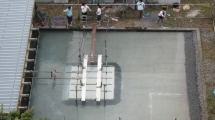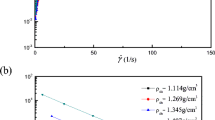Abstract
Wave decay over a muddy seabed has been widely reported. In previous studies, the fluid-mud layer is usually treated as a homogeneous layer with a certain thickness lying on the rigid bottom. However, the muddy seabed beneath a fluid-mud layer is usually movable in practice. This study aims to find out the influence of the movable seabed beneath a fluid-mud layer. For this purpose, a numerical model for wave propagation over a multilayered muddy seabed is developed, in which water is treated as a Newtonian fluid, and the rheology of mud is described by a visco-elastic–plastic model. The laboratory experiments of Sakakiyama and Bijker (J Waterw Port Coast Ocean Eng 115(5):614–633, 1989) are chosen to validate the numerical model. The model is then employed to investigate the movement of a fluid-mud layer with different conditions of the underlying mud layer and its influence on wave decay. It is found that the underlying mud layer plays a very important role in the wave–mud interaction and greatly affects the wave decay rate.







Similar content being viewed by others
References
An NN (1993) Mud mass transport under wave and current. PhD Thesis, Department of Civil Engineering, Yokohama National University, Yokohama, Japan
Dalrymple RA, Liu PL-F (1978) Waves over soft muds: a two-layer fluid model. J Phys Oceanogr 8:1121–1131
Gade HG (1958) Effects of a nonrigid, impermeable bottom on plane surface waves in shallow water. J Mar Res 16(2):61–82
Hall K, Oveisy A (2007). Wave evolution on fluid mud bottom. Coastal Sediments’07—Proceedings of 6th International Symposium on Coastal Engineering and Science of Coastal Sediment Processes, New Orleans, LA, United States.
Hirt CW, Nichols BD (1981) Volume of fluid (VOF) method for the dynamics of free boundaries. J Comput Phys 39:201–225
Huang L, Ng C-O, Chwang AT (2006) A Fourier–Chebyshev collocation method for the mass transport in a layer of power-law fluid mud. Comput Methods Appl Mech Eng 195:1136–1153
Jiang L, Zhao Z (1989) Viscous damping of solitary waves over fluid-mud seabeds. J Waterw Port Coast Ocean Eng 115(3):345–362
Jiang L, Kioka W, Ishida A (1990) Viscous damping of cnoidal waves over fluid-mud seabed. J Waterw Port Coast Ocean Eng 116(4):470–491
Maa JPY, Mehta AJ (1988) Soft mud properties: Voigt model. J Waterw Port Coast Ocean Eng 114(6):765–770
Macpherson H (1980) The attenuation of water waves over a non-rigid bed. J Fluid Mech 97(4):721–742
Mehta AJ, Lee S-C, Li Y (1994) Fluid mud and water waves: a brief review of interactive processes and simple modeling approaches. Florida
Mei CC, Liu K-F (1987) A Bingham-plastic model for a muddy seabed under long waves. J Geophys Res 92(C13):14581–14594
Ng C-O (2000) Water waves over a muddy bed: a two-layer Stokes’ boundary layer model. Coast Eng 40:221–242
Niu X (2008) Dynamic interaction between surface water waves and muddy seabed. PhD Thesis, Tsinghua University, Beijing, China (in Chinese)
Niu X, Yu X (2008a) A practical model for the decay of random waves on muddy beaches. J Hydrodyn 20(3):288–292
Niu X, Yu X (2008b) Visco-elastic–plastic model for muddy seabeds. J Tsinghua Univ (Sci & Tech) 48(9):37–41 (in Chinese)
Niu X, Yu X (2010) A numerical model for wave propagation over muddy slope. 32nd International Conference on Coastal Engineering (ICCE 2010), Shanghai, China.
Niu X, Yu X (2011) Numerical study on the movement of muddy seabed under waves. Proceedings of the Sixth International Conference on Asian and Pacific Coasts (APAC 2011), Hong Kong, China.
Rogers WE, Holland KT (2009) A study of dissipation of wind-waves by mud at Cassino Beach, Brazil: prediction and inversion. Cont Shelf Res 29:676–690
Sakakiyama T, Bijker EW (1989) Mass transport velocity in mud layer due to progressive waves. J Waterw Port Coast Ocean Eng 115(5):614–633
Shibayama T, Okuno M, Sato S (1990) Mud transport rate in mud layer due to wave action. Proceeding 22nd International Conference on Coatal Engineering, 3037–3049
Winterwerp JC, Graaff RFd, Groeneweg J, Luijendijk AP (2007) Modelling of wave damping at Guyana mud coast. Coast Eng 54(3):249–261
Zhao ZD, Lian JJ (1994) On the change of wave parameters for water waves propagating over a muddy bottom. J Tianjin Univ 27(5):521–528 (in Chinese)
Acknowledgments
The authors would like to acknowledge the support by the National Natural Science Foundation of China under the grant No. 51109119 and the Specialized Research Fund for the Doctoral Program of Higher Education of China under the grant No. 20110002120019.
Author information
Authors and Affiliations
Corresponding author
Additional information
Responsible Editor: Qing He
This article is part of the Topical Collection on the 11th International Conference on Cohesive Sediment Transport
Rights and permissions
About this article
Cite this article
Niu, X., Yu, X. Numerical study on wave propagation over a fluid-mud layer with different bottom conditions. Ocean Dynamics 64, 293–300 (2014). https://doi.org/10.1007/s10236-013-0686-1
Received:
Accepted:
Published:
Issue Date:
DOI: https://doi.org/10.1007/s10236-013-0686-1




